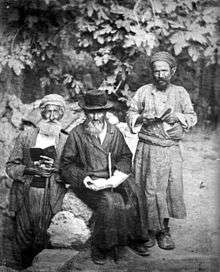Menachem Mendel of Vitebsk
| Old Yishuv |
|---|
 |
| Key events |
| Key figures |
|
| Economy |
| Philanthropy |
| Communities |
| Synagogues |
| Related articles |
Menachem Mendel of Vitebsk (1730?–1788),[1] also known as Menachem Mendel of Horodok, was an early leader of Hasidic Judaism. Part of the third generation of Hassidic leaders, he was the primary disciple of the Maggid of Mezeritch. From his base in Minsk Menachem Mendel was instrumental in spreading Hasidism throughout Belarus.
In the winter of 1772, he - along with Rabbi Shneur Zalman of Liadi (who regarded Rabbi Menachem Mendel as his Rebbe after the Maggid's passing) - went to the Vilna Gaon with the aim of convincing him to rescind his ban on Hasidism, but the Vilna Gaon would not receive them.
After the Maggid's death, Rabbi Menachem Mendel, along with fellow disciple Rabbi Abraham Kalisker ("Kalisker") settled in Horodok. In 1777 the two, along with 300 followers, emigrated to Eretz Israel,[1] settling in Safed, Ottoman Syria. In 1783 they were forced out of Safed, and moved to Tiberias. The synagogue they built there in 1786 still stands among the Ancient synagogues of Tiberias.
The Tanya (see "Compiler's Preface") is partially based on the works of Rabbi Menachem Mendel.
Menachem Mendel of Vitebsk is the subject of 15 of the stories in Martin Buber's Tales of the Hasidim.
Works
- P'ri Ha'Aretz
- P'ri Ha'Eitz
- Likkutei Amarim
References
- 1 2 Tauber, Yanki. "R. Menachem Mendel of Vitebsk (Horodoker) - Jewish Knowledge Base". Chabad.org. Retrieved 2015-05-17.
External links
- Menachem Mendel of Vitebsk: The Pioneering Rebbe by Rabbi Eliezer Melamed
- KALISKER, ABRAHAM BEN ALEXANDER HA-KOHEN, the Jewish Encyclopedia